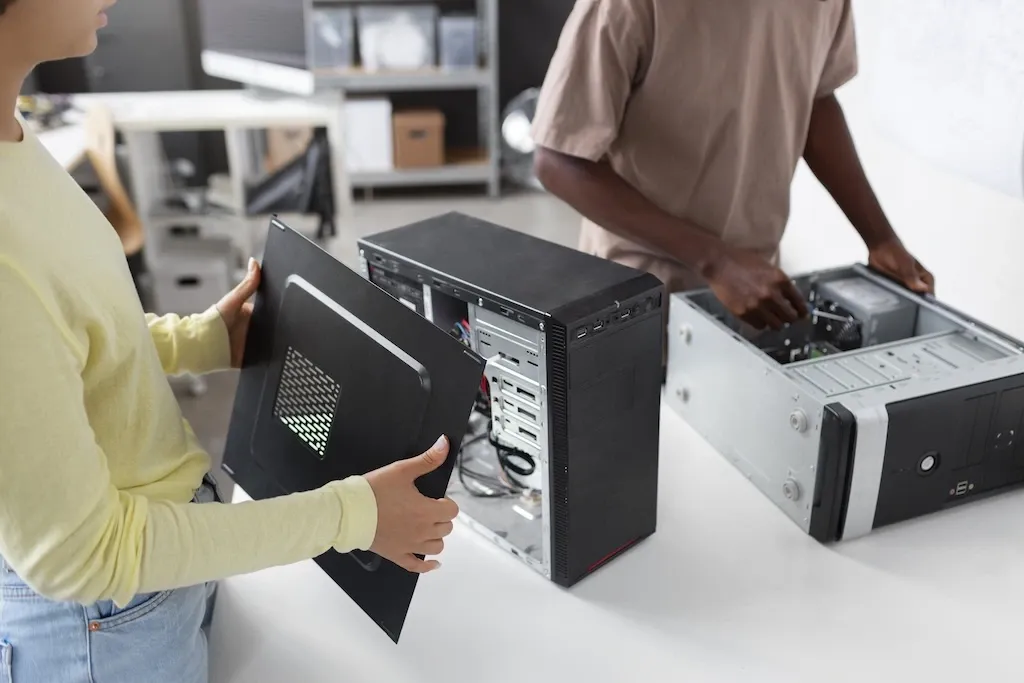Device Management for Remote Teams: Sourcing, Storing, and Delivering
Managing devices for remote teams isn’t as simple as handing out laptops in the office. When your team is spread across different cities or even countries, sourcing, storing, and delivering work equipment can quickly become a logistical challenge.
But how do you make sure that every employee has the right equipment to work without many logistical issues? And how to keep track of everything without a mess of spreadsheets? Keep reading, as in this guide, we will break down the simplest steps to setting up an effective device management system for your remote organisation.

Why effective device management matters
Effective device management isn’t just about convenience, but it’s an essential part of your organisation that keeps all of your operations running smoothly, securely, and cost-efficiently.
Starting from optimising productivity in the workplace, every employee needs reliable devices to do their jobs. A slow or faulty laptop can directly impact their productivity and lead to missed deadlines, poor performance, and overall frustration.
Without a proper system in place, you also risk security vulnerabilities and extra costs that could have been avoided. Lost or stolen devices, unencrypted data, or outdated software can put sensitive company information at risk and lead to data breaches, legal issues, and financial losses. A well-structured device management strategy will help you avoid these risks and make sure that all company devices are properly tracked, secured, and regularly updated.
Finally, establishing effective device management will ensure that your new employees get their devices quickly and departing employees return them easily. A structured process will save you a lot of money and time and ensure that no device in your company is left unaccounted for.

The challenges of device management for remote teams
Unlike traditional office setups where IT can directly manage hardware, remote device management brings a vast of different challenges that should be properly addressed. From sourcing equipment to delivering it to the right address and providing ongoing maintenance, every step needs careful planning to keep your operations running smoothly.
Sourcing the right devices
Providing your remote employees with the right devices is more than just picking up any laptop or phone. As an employer, you should find the best fit for their roles and ensure compatibility with your company systems. Hence, it’s important to balance security and budget while also considering factors such as device lifespan, scalability for future needs, and the employees' daily operations and performance requirements.
Secure storage
Not every employee will receive their devices right away, so it’s important to store them safely. Without a secure storage system, you risk damaging and even losing valuable business equipment. Proper inventory management, climate-controlled storage (for sensitive electronics), and efficient tracking systems will help you keep your company devices in top condition until they get deployed. Choosing a budget-friendly Windows VPS can also support your device management and tracking needs without straining your IT budget.
Efficient delivery
Shipping devices to remote employees, especially across different regions or countries, can be very complex. Logistics, custom regulations, and potential delays can disrupt new employees’ onboarding, as well as existing employees’ daily operations and timelines. So, planning the shipping process with a reliable service provider will ensure that your company devices arrive safely, on time, and at the right address.
IT support
When devices malfunction or require troubleshooting, your remote employees can’t just walk over to IT for a quick fix. So, businesses need a remote-friendly IT support system, typically done through an internal help desk, outsourced IT services, or remote troubleshooting tools. Having a quick and effective IT support solution will help you minimise downtime and keep your team more productive.
Software management
Managing software installations, updates, and security patches remotely is another challenge. Without centralised control, it’s not uncommon for employees to use outdated or unapproved software, which can highly increase security risks. Hence, implementing mobile device management (MDM) or endpoint management solutions can help you enforce security policies, monitor compliance, and ensure that your employees always have access to the right tools for work.
Cost control
Unmanaged device expenses can quickly add up. Initial purchases, repairs, replacements, and many other costs - you must have a clear budget and a tracking system to avoid spending more than you should. Having a strategic approach, such as bulk purchasing, leasing options, and buyback programmes, can help you optimise your device management expenses while also giving you access to the right equipment for your team members.

Steps for efficient device management
Managing devices for your remote team requires a structured approach to ensure that your employees have the right resources while maintaining security, efficiency, and cost control at the same time. Below, we discuss a few of the steps you can take to plan your device management in a way that minimises risks, reduces downtime, and improves the overall productivity of the process.
Sourcing the right devices
The first and most crucial step of efficient device management is identifying the specific needs of your team. So, start by making a plan regarding the type of work your employees do, the software they need, and the security they require. High-performance devices may be necessary for developers and designers, while customer support teams might need simpler setups.
Hence, opting for standardised devices will simplify your IT support and overall software management. Additionally, working with trusted suppliers or using bulk purchasing options can reduce your costs and ensure consistent quality.
Storing and inventory management
Not all devices you purchase will go straight to your employees - some may need to be stored for future hires, replacements, or temporary use. Ensuring that your devices are properly stored will prevent damage, theft, or loss.
So, implementing an inventory management system will allow you to track devices in real-time, log device cycles, and schedule maintenance or upgrades when needed. By doing this, you can make sure that your equipment is always ready when required.
Delivering devices to remote employees
When working with a team across multiple countries, it’s important to ensure safe and efficient device shipping. Some upfront considerations, such as choosing a reliable logistic partner, understanding customs regulations, and using tracking solutions, will help you prevent unnecessary delays and make sure that your employees receive their equipment on time.
In addition to secure and timely delivery, it’s also important to consider pre-configuring devices with the necessary software and security settings. Doing this before shipping will help you streamline your new employees’ onboarding process and save time for more important tasks.
Secure device usage and maintenance
Once your company devices are in use, it’s essential to ensure ongoing security and maintenance. Implementing remote device management software will help you monitor system health, install updates, and enforce security policies.
Businesses should also educate their employees on cyber security practices, such as avoiding public WI-FI for work and using multi-factor authentication. Having a clear policy on device handling, security updates, and data protection will reduce the risks of cyber threats and hardware failure.
Device retrieval and upgrades
When employees leave or require device upgrades, having a structured process for retrieving and refurbishing devices will prevent unnecessary costs and security risks. Devices should be securely wiped, refurbished for reuse, or properly disposed of through recycling programmes.
In addition to this, some companies also use buyback or trade-in programmes to manage hardware replacements more cost-effectively.
Cost and lifecycle management
Keeping track of expenses related to device purchases, maintenance, and replacements will help your company optimise spending management. A lifecycle management strategy will ensure that all your company devices are used efficiently for their full lifespan before planning for future upgrades.
Therefore, monitoring warranties, repair costs, and overall device performance will help you determine when replacing rather than repairing is more cost-effective. With the right approach, businesses can ensure their employees are equipped with all the devices they need while their device management costs are optimal and under control.

How Native Teams simplifies device management for remote teams
Managing devices for a globally distributed team can be complex, and this is why Native Teams makes it very simple for global employers. With our device management services, every business can easily purchase, store, and deliver work equipment to remote employees without any issues with international shipping, delays, and high costs.
Instead of dealing with multiple global providers, Native Teams sources equipment locally in the employee’s country, ensuring faster, more secure delivery and compliance with all the local regulations. Once ordered, the device is shipped directly to the employee, which eliminates logistical hassles and optimises costs for business owners.
Native Teams provides a streamlined approach to remote device management, which saves you a lot of valuable time and ensures that your team members across the globe have access to the right tools and equipment quickly and without any issues.

Wrapping up
Managing devices for remote teams isn’t just about buying laptops, but it’s about making sure that your employees have the right tools at the right time, without unnecessary issues. Having a solid device management system in place will help you tackle the process from sourcing and storage to delivery across the globe, as well as make your team ultimately more productive and efficient.
With the right approach, strategic planning, and a reliable partner, device management can become a simple process that keeps your operations smooth and your global team equipped for success.
